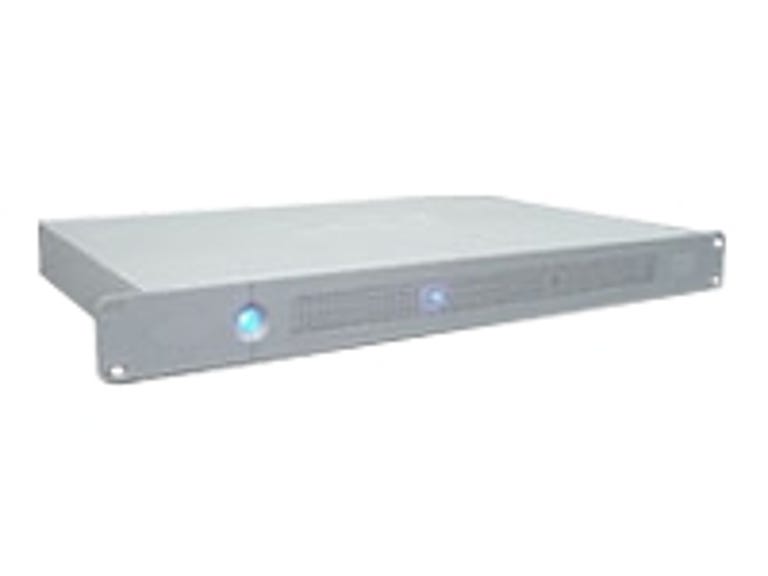 Why You Can Trust CNET
Why You Can Trust CNET LaCie Ethernet Disk review: LaCie Ethernet Disk
The Ethernet Disk is a suitable means of adding storage to a small business network, but it lacks the power and the expansion options of a full-fledged server.
One of the more acute growing pains that comes with owning a successful small business is the need for increased IT resources. Adding a server to your business, for example, has traditionally meant paying for the know-how to install and maintain it. But now, low-cost, uncomplicated server alternatives, such as the LaCie Ethernet Disk, are giving small-business owners do-it-yourself options for expanding their networks. The Ethernet Disk is a beefed-up network-attached storage unit that that runs embedded Windows XP and comes in six different configurations, adding anywhere from 80GB to a full terabyte of disk space to your network. We think the Ethernet Disk's mix of features makes it a good fit for many small businesses looking for a file server to share files and folders among their workforce, but given the unit's lack of RAID support and weak expansion options, it's worth considering the soon-to-be released Buffalo TeraStation as an alternative.
LaCie's Ethernet Disk is designed as a rack-mountable unit, but you can also place it on top of a table or a desk. The Ethernet Disk's case is designed to support up to 55 pounds, which makes it sturdy enough to act as a base for an LCD monitor, too. A printed installation guide walks you through the setup process, which you perform via the unit's browser-based Administration tool. The tool lets you set up and customize shared folders, add and modify users and groups, and assign user permissions, and it's very easy to use. We had the unit connected to our network and configured to share files in less than 30 minutes.
The Good
The Bad
The Bottom Line
The most notable feature of the Ethernet Disk is its embedded Windows XP operating system, which bestows upon the unit most of the powers of a full-fledged Windows PC and gives it a convenient and familiar interface for entrenched Windows users. You can even access the Ethernet Disk from a remote Windows PC using XP's built-in remote desktop connection utility, which lets you control the unit as you would any other computer running Windows XP, setting file and folder permissions and adding and deleting users and user groups.
The Ethernet Disk's hardware features include one 10/100 Ethernet port for attaching the unit to your network, two USB 1.1 ports that let you connect external USB hard drives, one FireWire port for connecting an external FireWire drive, ports for the mouse and the keyboard; and one VGA connector for attaching a display directly to the unit.
LaCie advertises the Ethernet Disk's interoperability with Windows, Mac, Linux, and Unix systems, but this cross-platform compatibility has its limits. Linux/Unix support is available only with SMB/Samba message format, not via the lighter and faster NFS, and interoperability with Mac OS X restricts filenames to 31 or fewer characters.
LaCie claims its Ethernet Disk is capable of supporting as many as 25 simultaneous users. Given the unit's single 7,200rpm drive, lack of RAID support, lack of a Gigabit Ethernet adapter, and modest 2MB buffer (8MB on units larger than 160GB), we see 10 simultaneous users as a more realistic number. To make matters worse, expanding the unit's storage via its poky USB 1.1 ports will slow transfers to a crawl whenever these drives are connected. Why LaCie chose to outfit the Ethernet Disk with USB 1.1 and not USB 2.0 ports is a mystery to us.
LaCie offers a meager one-year warranty on its Ethernet Disk, although oddly, customers in Europe get a more attractive two-year warranty. Phone support is included as part of the service package, but it's via a toll call and the lines are staffed only Monday through Friday from 7 a.m. through 5 p.m. PT. LaCie hosts a few useful technical resources for the Ethernet Disk on its Web site, including a downloadable product manual, a white paper on the technologies that make up the Ethernet Disk, a product data sheet, and a series of free downloadable patches for the unit's embedded XP OS. Unfortunately, the site currently lacks a FAQ for the Ethernet Disk and makes no provisions for user group support. For a product marketed as mission critical equipment for small businesses, the Ethernet Disk's short warranty, limited phone support, and paltry technical-resource offering on LaCie's Web site are disappointing.
